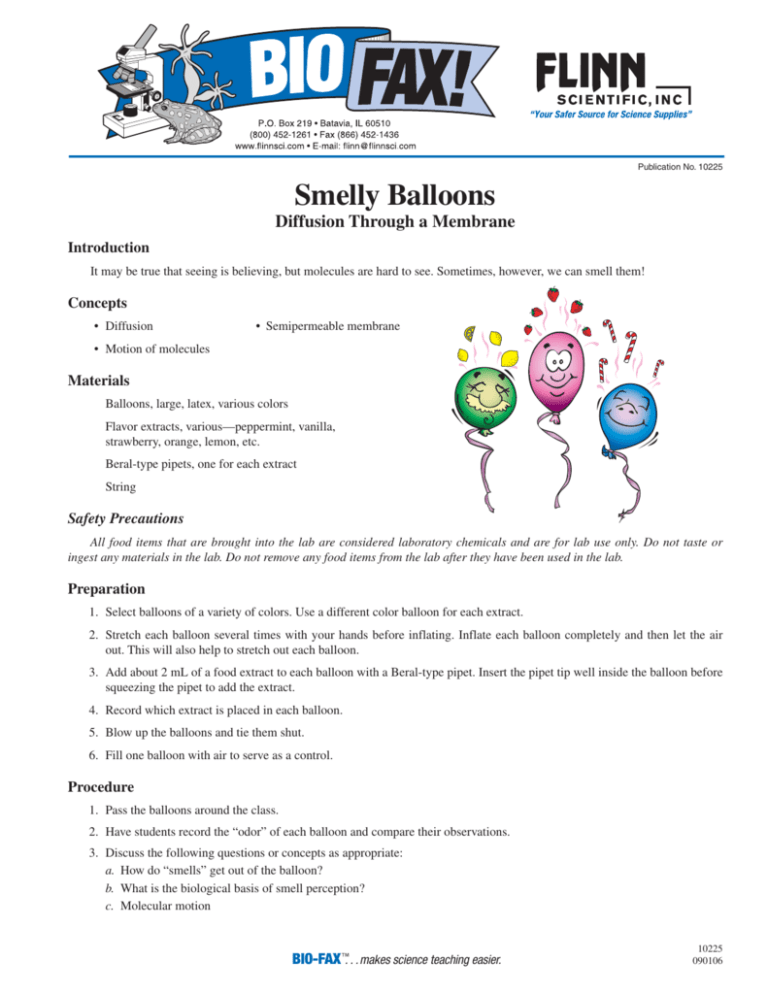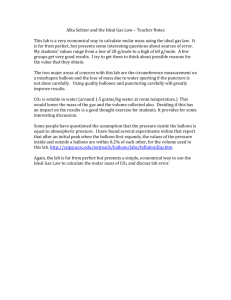
Publication No. 10225
Smelly Balloons
Diffusion Through a Membrane
Introduction
It may be true that seeing is believing, but molecules are hard to see. Sometimes, however, we can smell them!
Concepts
• Diffusion
• Semipermeable membrane
• Motion of molecules
Materials
Balloons, large, latex, various colors
Flavor extracts, various—peppermint, vanilla,
strawberry, orange, lemon, etc.
Beral-type pipets, one for each extract
String
Safety Precautions
All food items that are brought into the lab are considered laboratory chemicals and are for lab use only. Do not taste or
ingest any materials in the lab. Do not remove any food items from the lab after they have been used in the lab.
Preparation
1. Select balloons of a variety of colors. Use a different color balloon for each extract.
2. Stretch each balloon several times with your hands before inflating. Inflate each balloon completely and then let the air
out. This will also help to stretch out each balloon.
3. Add about 2 mL of a food extract to each balloon with a Beral-type pipet. Insert the pipet tip well inside the balloon before
squeezing the pipet to add the extract.
4. Record which extract is placed in each balloon.
5. Blow up the balloons and tie them shut.
6. Fill one balloon with air to serve as a control.
Procedure
1. Pass the balloons around the class.
2. Have students record the “odor” of each balloon and compare their observations.
3. Discuss the following questions or concepts as appropriate:
a. How do “smells” get out of the balloon?
b. What is the biological basis of smell perception?
c. Molecular motion
BIO-FAX姠. . .makes science teaching easier.
10225
090106
Teacher’s Notes continued
d. Diffusion
e. Semipermeable membranes
Discussion
The balloon is a semipermeable membrane that allows the selective passage of molecules through its apparent boundary.
Molecules small enough to fit through the “holes” in the balloon membrane will diffuse through the membrane, both into and out
of the balloon. The flavor extracts are mixtures of small organic molecules that, in general, are small enough to “fit” and thus diffuse through the balloon membrane. Eventually, the diffusing molecules reach the smell-sensing areas of the human nose and the
molecules are detected as a smell outside of the balloon. Stored patterns of previous smells in our brains are used to interpret the
recent and usually recognizable odors.
Disposal
Balloons can be deflated and tossed in the solid waste trash can.
Tips
• Flavor extracts may be purchased at grocery stores.
• Time each extract to see if one balloon allows all of its extract to escape faster than another.
• Compare the rate at which air escapes and the balloons deflate to the rate at which the smells escape.
• Does stretching the balloon before inflating it change the size of the “holes” and thus the rate at which the molecules
escape? Hint: Try one balloon that has been inflated several times versus a new, uninflated balloon.
• Compare the rate of diffusion of an extract through a latex balloon versus a Mylar® balloon.
Connecting to the National Standards
This laboratory activity relates to the following National Science Education Standards (1996):
Unifying Concepts and Processes: Grades K–12
Evidence, models, and explanation
Content Standards: Grades 5–8
Content Standard A: Science as Inquiry
Content Standard B: Physical Science, properties and changes of properties in matter
Content Standard C: Life Science, structure and function in living systems
Content Standards: Grades 9–12
Content Standard A: Science as Inquiry
Content Standard B: Physical Science, structure and properties of matter
Content Standard C: Life Science, matter, energy and organization in living systems
Materials for Smelly Balloons are available from Flinn Scientific, Inc.
Catalog No.
AP1900
Description
Balloons, Latex, Assorted Colors
Consult your Flinn Scientific Catalog/Reference Manual for current prices.
–2–
© 2006 Flinn Scientific, Inc. All Rights Reserved.
10225








